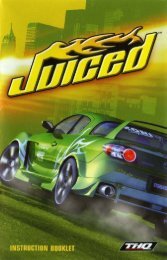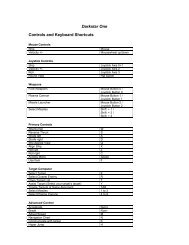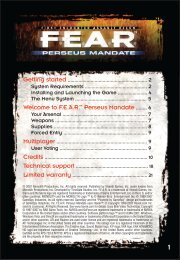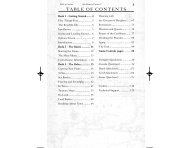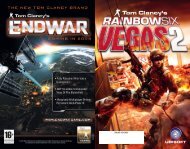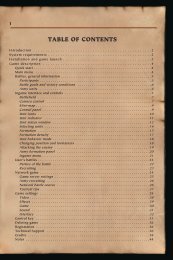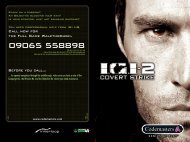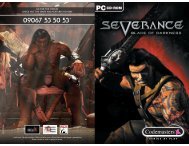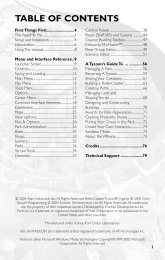Heads-Up Display Modes 35 - Metaboli
Heads-Up Display Modes 35 - Metaboli
Heads-Up Display Modes 35 - Metaboli
Create successful ePaper yourself
Turn your PDF publications into a flip-book with our unique Google optimized e-Paper software.
126 Air Combat Basics<br />
your radar can detect that aircraft). Use AWACS data (or other datalinked radar<br />
information) to trap or ambush the enemy.<br />
If AWACS isn’t available, then the aircraft assigned to the mission must conduct<br />
their own air searches. Keeping in mind the limitations of the scan cone, flight<br />
leaders should order formations that allow effective searches of wide areas. Two<br />
aircraft flying in close, finger-tip formation effectively limits both aircraft. Horizontal<br />
separation lets two aircraft search a wider area; vertical separation lets them<br />
search a taller area.<br />
Vertical and horizontal spacing also complicates the enemy’s ability to track and<br />
detect friendly aircraft. Enemy search radars on fighter aircraft also have limited<br />
scan cones. Widely spacing friendly aircraft may keep some of them outside the<br />
enemy scan cone. Further, this aircraft is free to maneuver while the enemy<br />
focuses attention on the detected aircraft. The second aircraft can maneuver<br />
around and engage the enemy from its flank or rear while the first aircraft lures<br />
the enemy fighters into the trap.<br />
When forced to conduct your own long-range searches, keep in mind that the<br />
radar cross section (RCS) of the target determines how far away the Flanker’s<br />
radar will detect it. Large bombers will generally be detected much farther away<br />
than tactical aircraft. Also, ground clutter generally helps mask targets.<br />
Consequently, lower-altitude targets usually can’t be detected at longer ranges.<br />
Maneuvers<br />
While the goal of any interceptor is to engage with long-range missiles and<br />
escape, dogfights inevitably erupt.<br />
hAir combat is not a chess game. Pilots do not use specific maneuvers<br />
to “counter” enemy movements. Air combat is a fluid, dynamic,<br />
constantly changing environment. Rather than thinking “he did a split-<br />
S, so I’ll counter with a high yo-yo,” pilots instead consider where they<br />
need to point their aircraft in order to employ their weapons. They then<br />
execute the appropriate maneuver to adjust their lift vector and bring<br />
their aircraft into a firing position.<br />
The Break Turn<br />
The most basic defensive maneuver is the break turn. In this case, the pilot turns<br />
toward the threat aircraft to increase aspect angle and ruin the opponent’s firing<br />
solution. Generally speaking, a break turn indicates a maximum-performance turn,<br />
using all available instantaneous g.<br />
As an attacker, if the target executes a defensive break turn, you will generally<br />
resort to the high yo-yo to prevent overshooting.<br />
The High Yo-Yo<br />
The high yo-yo uses a relatively quick movement out of the target’s plane of<br />
motion to either slow closure rate or to reduce aspect angle to the target. The<br />
high yo-yo is performed by rolling slightly behind and above the target,extending<br />
behind the target’s flight path for a moment, then rolling back toward and pulling<br />
the nose down to the target. The high yo-yo generally increases the range to the<br />
target, but decreases the aspect angle, setting up a firing opportunity. The length



